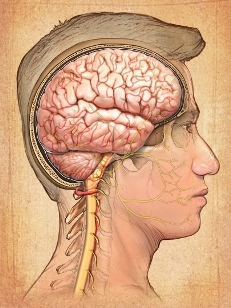Penetrating brain injury
Description penetrating brain injury
This type of injury occurs, when an object penetrates the skull and damages the brain. It may be damaged only a small or rather large part of the brain . This is a serious, a life-threatening injury, which requires emergency medical care.

Causes of penetrating brain injury
Penetrating brain injury can impact outside vyzvant:
- Drop (may cause, that part of the skull bones may break away and enter the brain);
- Car accident;
- Gunshot wound to the head;
- Stabbed in the head;
- Sports injuries.
Risk Factors penetrating brain injury
Risk factors include:
- Elderly (High risk of falls) or young (a high risk of accidents) age;
- Alcohol abuse or drugs;
- The high probability of violence;
- Occupation sport with a high probability of impact to the head.
Symptoms of penetrating brain injury
Penetrating brain injury is very serious and can cause death. Gunshot wound to the head is often fatal. Symptoms of injury, However, They vary depending on the extent and cause of damage. Symptoms may include:
- Heavy bleeding from the head;
- Bleeding from the ears;
- Labored breathing;
- Convulsions;
- Loss of function of the intestine and the bladder;
- The loss of motor function or sensation in the limbs (paralysis);
- Loss of consciousness (after injury can occur coma).
Diagnosis of penetrating brain injury
Since the injury is very serious, the victim as quickly as possible should be taken to the emergency room. Diagnosis may include:
- Checking heart and lung;
- Checking the level of consciousness;
- Test your reflexes, strength and sensitivity;
- Examination of the victim to find other injuries.
Depending on the condition of the patient, It may be carried out following tests:
- Roentgen and CT scan of the head and spine;
- Blood tests;
- MRT (It may be carried out, once the condition of the victim has stabilized).
Treatment of penetrating brain injury
The treatment plan depends on several factors, including:
- The severity of the injury;
- Areas of the brain, which was damaged;
- Symptoms.
Initial treatment of penetrating brain injury
The hospital staff will first try to stabilize. If there is bleeding, measures will be taken, to stop it as soon as possible. This may require emergency surgery. To help a person breathe, in the throat and lungs may be placed snorkel. Besides, infusion with fluid and blood, to maintain a stable blood pressure.
Operation
Depending on the type of injury, neurosurgeon (doctor, who specializes in operations of the brain and spinal cord) makes the following:
- Removal of the skull fragments, who broke away during injury. Bullet or other object as possible should be removed;
- Removal of the skull (decompressive craniectomy) – after a severe brain injury often expands and swells. Removal of the skull gives the brain room for expansion;
- Performed a hole in the scalp and skull bone to remove blood clotting;
- For the drainage of cerebrospinal fluid in the brain is set catheter.
The doctor can also place in the brain, some devices, to control:
- Pressure in the brain;
- The temperature and brain oxygen levels.
Medication
After a traumatic brain injury may experience seizures. Because of this, your doctor may prescribe antiseizure medication. Strong pain relief medication, such as opioids, They may be introduced through a vein in the hand.
Rehabilitation
After improving the health, the doctor will develop a rehabilitation program, which may include:
- Classes with a physiotherapist;
- Occupational therapy;
- Going to the doctor, who specializes in physical medicine and rehabilitation;
- Classes with a neurologist;
- Sessions with a psychologist.
The goal is, to help a person recover, as much as possible, the functionality of the body.
Prevention of penetrating brain injury
Ways to prevent this type of brain injury:
- Reducing the risk of accidents with guns:
- Keep the weapon discharged in a locked cabinet;
- Store ammunition in a separate place, which also is closed;
- Ways to reduce the risk of falls, especially for the elderly:
- Use handrails when walking on stairs;
- Use handrails in the bathroom and placing non-slip mats in the bathtub;
- Reducing the risk of road accidents:
- You can not drive a car drunk or get into a car with a driver, which is under the influence of alcohol;
- Observe speed limits and other traffic regulations;
- Use seat belts and child seats for child safety;
- Wear a helmet when engaging in certain sports and when riding a motorcycle;
- Avoid taking drugs, that cause drowsiness, especially when driving.
